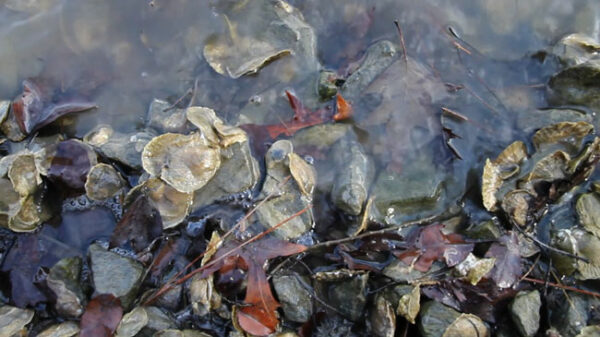By JESSICA WILDE
Capital News Service
MCDANIEL, Md. – A warmer, drier year has been good for oysters, both natural and planted, in the Eastern Shore’s Harris Creek, a tributary of the Choptank River and site of the first tributary-wide restoration effort by the Oyster Recovery Partnership.
The partnership has been working on Harris Creek for about a year, putting hard substrate down for oysters to grow on, and planting spat, or baby oysters, on top of it.
Scientists have found that many of the planted oysters are surviving. In addition, and somewhat surprisingly, other oysters on the shoreline that are not part of the project are restoring themselves naturally because of good conditions last year.
While some environmentalists argue that hard substrate and good conditions are enough to restore oysters, scientists on the project believe restoration efforts need to continue to be more extensive because we cannot always rely on good conditions.
Choptank Riverkeeper Drew Koslow found thousands of naturally reproducing oysters on the shoreline of the creek in December, more than any he has seen in years past – a sign, he said, that when conditions are right, the system will come back.
Oysters play a significant role in the bay’s health, filtering water and improving its quality, and eating algae, which allows sunlight through to underwater grasses. Their reefs also provide habitat for other marine life.
Many believe that by restoring oysters, the bay can also be restored.
But it is not that easy. The Oyster Recovery Partnership has been working for nearly 20 years, and its latest tributary-wide effort is in response to President Barack Obama’s 2009 executive order to restore the Chesapeake Bay.
“The system is resilient,” Koslow said. “And I think that’s what this demonstrates, that you give it a chance, you stop harvesting oysters and you build up populations. And if we can do that, I think we can restore the bay.”
Koslow attributes this year’s oyster success to a drier climate, which increases salinity that oysters like, and higher temperatures, since a long freeze might kill oysters on the shore.
“In our business, you don’t have a lot of good news,” he said. “It’s nice to have something we can smile about.”
Koslow said it makes sense to him to just put down hard substrate and allow nature to take its course.
“Because obviously there’s plenty of natural reproduction in this creek already,” he said.
But while this year’s conditions were good, the senior manager of aquatic restoration at the Oyster Recovery Partnership, Steven Allen, said they cannot rely on naturally reproducing oysters alone to restore the population. You can’t always predict that conditions will be right, he said, which is why the partnership is also planting oysters.
The partnership is working with the U.S. Army Corps of Engineers and other state and federal agencies to plant the hard substrate and baby oysters in 20 tributaries in Maryland and Virginia.
“If we knew what Mother Nature was going to do for us, and we could predict that water temperatures and salinity would be ideal and everybody in the creek would cooperate and we’d have multiple natural recruitments during the summer, I think putting substrate down would be an excellent choice,” Allen said. “However, we don’t have that crystal ball.”
Allen said high salinity levels are also a Catch-22. While they might lead to natural recruitment, they also increase the chance that oysters will catch diseases, one of the many reasons their population is at risk to begin with, along with overharvesting and loss of habitat.
Ken Paynter, director of the Paynter Lab that monitors the partnership’s work, called the success that Koslow found a “perfect storm of natural recruitment.” Paynter is director of the University of Maryland’s Marine, Estuarine and Environmental Sciences graduate program.
His lab found a small amount of natural recruitment on the planted hard substrate as well, but not nearly as much as Koslow found on the shoreline.
“It really wasn’t the kind of natural recruitment we’d like to see,” Paynter said about the oysters on the substrate. They measured 8-10 oysters per square meter, but they would ideally like to see 50-100 oysters per square meter.
Paynter said the lab should be monitoring a lot more than it is, counting naturally recruiting oysters like those that Koslow found, in addition to monitoring the planted oysters and substrate.
“There’s lots to be done,” he said.
View Harris Creek in a larger map



